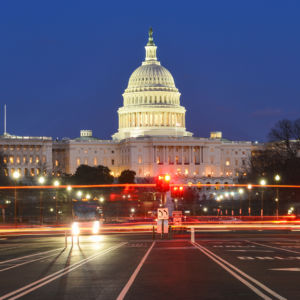I recently had the pleasure of walking through Washington’s tourist-packed Capitol Visitors Center and admiring the extraordinary collection of monuments assembled there. I was headed to a small auditorium to deliver my Economic Situation Report to a group of congressional staffers as a part of the Mercatus Center at George Mason University’s “Capitol Hill Campus” program.
What I observed that day left a memory that I’ll carry for years to come. Let me explain.
It was spring break, bringing students from the Washington area and beyond. The Visitors Center was swarming with children. Chasing and herding after them were teachers and parents. Some of the kids seemed to be listening as presentations were underway; others were more interested in yanking at the jackets of the person sitting next to them; and a few were simply eyeing the splendid surroundings, just as I was.
With amazing success, the teachers were able to settle small groups of children around some of the statues where stories about America’s great women and men formed the lessons for the day.
There are 24 statues in the center and many more in other areas of the Capitol. Each was selected and provided by one state. The bios of the historic figures captured the attention of the children, their teachers and me.
North Dakota’s selection, Sakakawea, was surely one of the winners. A Shoshone Indian and wife of French-Canadian trapper and guide Pierre Charbonneau, she accompanied Lewis and Clark on their western expedition. Sakakawea, whose name is sometimes spelled Sacajawea, served critically as an interpreter and expedition peacemaker when unknown Native American tribes were encountered. Her life-size statue is rendered complete with papoose.
Helen Keller, an Alabama contribution, was born in Tuscumbia, Ala., in 1880. She lost her sight, hearing and ability to speak when just 19 months old. She will always be remembered for her successful struggle to learn to speak and to communicate with Braille — this and more with the extraordinary assistance of her lifetime teacher Anne Sullivan. The schoolchildren learned that Helen Keller accomplished practically impossible feats; she ultimately graduated from Radcliffe College.
Ernest Gruening, Alaska’s gift to the collection, demonstrated how much variety can be achieved in a lifetime. This New York City native was a graduate of Harvard medical school, but one who did not practice medicine. Instead, he pursued an outstanding journalism career, served in World War I, and then became a federal government executive specializing in the management of U.S. territories. This carried him to Puerto Rico and later to the Territory of Alaska, where he served as governor and as senator when the state was formed in 1959.
As I watched the children that day, I realized once again that America is a growing collection of stories about the human free spirit that must be continually compiled and retold. The stories are rendered in innumerable ways by countless people, sometimes even in the nation’s Capitol.
Some people will hear them and be inspired to live out dreams that otherwise might not be kindled. Others will feel for the first time that they, like me, are a part of something wonderful and almost magical — a country where countless ordinary people can live extraordinary lives, provided, of course, that we let freedom ring.
As I reviewed the list of state-provided statues, I realized that most were individuals who lived more than 100 years ago. States sometimes replace their statues, and I couldn’t help but wonder about future nominees. Will future Capitol Hill visitors find an equally outstanding array of uncommon Americans? Let’s hope so.
It was raining cats and dogs in Washington the day of my visit. But there was a special warmth inside the Capitol Visitors Center.

